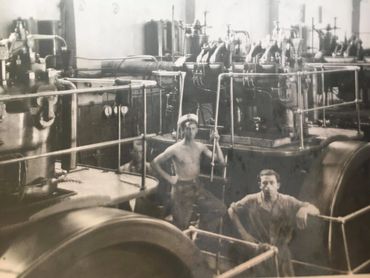Signed in as:
filler@godaddy.com
Signed in as:
filler@godaddy.com
Richard was born in Bargoed, South Wales. He left school to work in the Power House in Bargoed for Powell Duffryn he soon realised that was not for him, he then at the age of 18 joined the Royal Naval Fleet Air Arm.
Family stories tell us that Richard saw his brother in law (Stan) looking rather smart and dapper in his Royal Navy uniform, and so decided that's what he wanted. He entered service with the Royal Navy Fleet Arm and was sent to Scotland for training, from Scotland he was posted to the aircraft carrier HMS Hermes.
He had palled up with a fellow "Taff" (whom sadly did not survive the Hermes bombing) they travelled by ship to Africa and then across country by rail to the other side of Africa to join HMS Hermes.
In February 1941, Hermes supported Commonwealth forces in Italian Somaliland during the East African Campaign and did much the same two months later in the Persian Gulf during the Anglo-Iraqi War. After that campaign, Hermes spent most of the rest of the year patrolling the Indian Ocean. She was refitted in South Africa between November 1941 and February 1942, which was probably when Richard joined the ship,. Hermes then joined the Eastern Fleet at Ceylon.
Hermes was berthed in Trincomalee on 8 April 1942. Richard told his family that a Japanese scout plane spotted her near Batticaloa following which the Admiralty notified the Hermes that the Japanese air fleet was heading for Trimomalee to bomb the naval fleet. The Admiralty in charge ordered all vessels out of the Harbour, this was because if ships were sunk in the harbour it would cause difficulty getting in and out of. All aircraft were ordered to leave the decks.
Out into the South China Sea the Hermes went and on 9th April 1942 at 10.45am it received 40 direct hits from the Japanese air fleet. (It was the same Japanese ai rfleet that had bombed Pearl Harbour). Richard recalled when the bombs hit Hermes he was below deck and that he must have been knocked unconscious. When he recovered consciousness the Hermes was listing badly and the only way up was to scramble up through a lift shaft. He told when he eventually managed to get on deck Hermes was listing badly and he could not see anyone, which made him think afterwards he was probably one of the last to get off.
There was a big gun gantry on board Hermes and someone had tied a rope to it so men could lower themselves safely into the water. By the time Richard got there, because Hermes was listing badly, and time was running out, he did an almighty Tarzan type lunge, grabbed the rope, and lowered himself into the water and swam away from the Hermes.
Once in the water he managed to grab on to a piece of wood and told the family he was floating in oil, they had been told to keep in oil because that would keep the sharks away. He was in the water a long time. A little boat, looking for survivors approached him, they shouted "are you ok" Richard replied he wasn't injured, their response was they were looking for seriously injured survivors and would return. He was eventually picked up by the USA hospital ship "Vita" some 5 hours later. He was, together with other survivors, taken to Kenya to convalesce.
307 men lost their lives in the sinking of Hermes. Richard never spoke much of his experience on Hermes, it was only in the last few years of his life he went into detail. He then went on to do 25 years service in the Royal Navy spending long periods on HMS Ark Royal and finally retiring from the RN as a lieutenant.
This story was told to us by Richards daughter Lesley.

Richard Groom














